You’ll benefit from wearable pregnancy tracking through continuous health monitoring that detects complications like preeclampsia and gestational diabetes before they escalate. These devices track your heart rate, blood pressure, glucose levels, and fetal wellbeing 24/7, providing early warnings that can reduce preterm delivery risk by 48%. You’ll also receive personalized care recommendations, maintain healthy weight gain, and improve communication with your healthcare team through automated data sharing that enhances both maternal and infant outcomes throughout your journey.
Real-Time Health Parameter Monitoring During Pregnancy
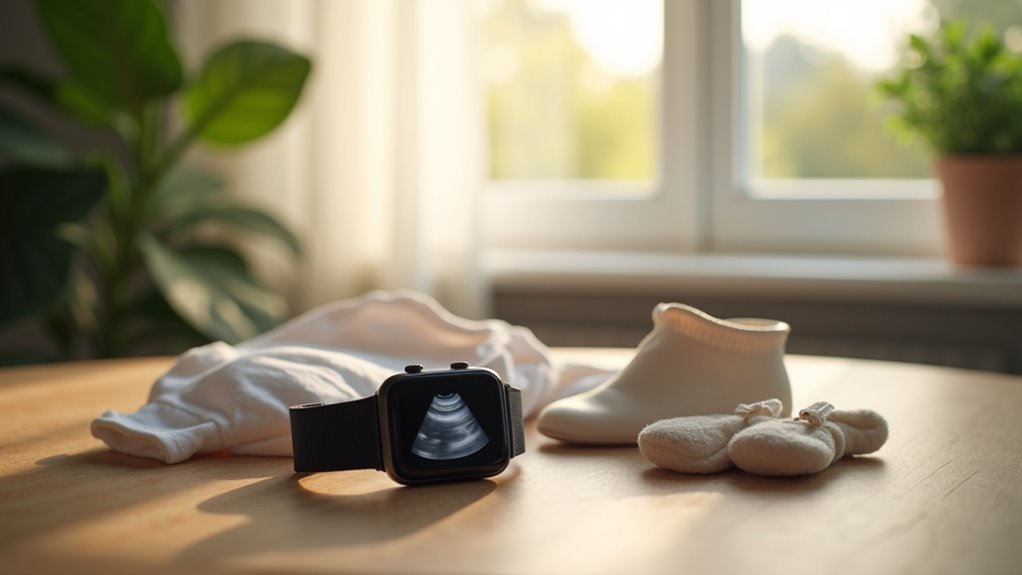
While traditional prenatal care relies on periodic checkups, wearable technology transforms pregnancy monitoring by tracking your health parameters continuously throughout the day.
These devices monitor your body temperature, motion patterns, and other essential signs, providing extensive insights into your pregnancy journey. You’ll receive real-time data about fetal heart rate and contractions, giving you immediate insights into your baby’s well-being.
The continuous monitoring helps identify deviations from normal health patterns that might indicate potential risks, allowing for early intervention. Research shows that better sleep and activity patterns are associated with a 48% reduction in preterm delivery risk. This constant stream of health data enables your healthcare provider to make more informed decisions about your care, moving beyond the limitations of traditional periodic assessments to create a complete picture of your pregnancy health.
Early Detection of Gestational Complications
You can catch serious pregnancy complications before they become life-threatening through continuous monitoring of three critical health indicators.
Your wearable device tracks heart rate variability patterns that signal potential preeclampsia, monitors glucose fluctuations that reveal gestational diabetes risk, and detects blood pressure changes that warrant immediate medical attention.
This real-time surveillance transforms how you’ll identify and respond to complications that affect 15-20% of pregnancies worldwide. The technology sends immediate alerts to medical teams when readings fall outside your typical range, enabling intervention between routine OB-GYN visits.
Heart Rate Variability Monitoring
As your body adapts to pregnancy’s increasing demands, your autonomic nervous system (ANS) works overtime to regulate critical functions like blood flow, oxygen delivery, and nutrient transport to your growing baby.
Heart rate variability (HRV) monitoring reveals how well your ANS balances these demands. HRV measures the variation between successive heartbeats, providing real-time insights into your body’s stress response. Wearable devices can track these subtle changes continuously, offering valuable early warning signs. These hemodynamic adjustments are primarily what the ANS regulates throughout your pregnancy journey.
- High HRV indicates healthy ANS balance and good adaptation
- Low HRV suggests increased risk of complications like gestational hypertension
- Declining RMSSD and HF parameters signal mounting stress or anxiety
- Abnormal patterns often appear before clinical symptoms develop
This monitoring enables timely interventions and personalized care.
Glucose Level Tracking
Between 2% and 10% of pregnancies develop gestational diabetes mellitus (GDM), making glucose monitoring one of the most critical aspects of prenatal care. You’ll benefit from continuous glucose monitoring (CGM) technology that detects GDM earlier than traditional methods, achieving 89% accuracy using first-trimester data.
| Detection Method | Accuracy (AUC) | Timeline | Advantages |
|---|---|---|---|
| CGM Parameters | 0.953 | First trimester | Real-time monitoring |
| Traditional OGTT | 0.722 | 24-28 weeks | Standard protocol |
| Machine Learning | 89% accuracy | Early pregnancy | Predictive analysis |
| Wearable Integration | High precision | Continuous | Non-invasive tracking |
You’ll receive real-time glucose data that enables immediate treatment adjustments, reducing complications like large-for-gestational-age babies and cesarean sections. This technology enhances compliance while providing cost-effective monitoring compared to multiple clinic visits. Research demonstrates that CGM devices prove especially effective for multiethnic Asian pregnant women with overweight or obesity conditions.
Blood Pressure Detection
While traditional prenatal visits capture blood pressure only during scheduled appointments, continuous wearable monitoring detects the subtle fluctuations that often signal developing complications.
You’ll benefit from round-the-clock tracking that captures changes missed during routine office visits, enabling early detection of serious conditions like preeclampsia.
Wearable blood pressure devices offer significant advantages:
- Real-time alerts notify your healthcare provider when readings deviate from normal ranges
- Comfort and compliance encourage consistent use compared to traditional cuffs
- Fluid volume detection identifies changes that precede preeclampsia onset
- Remote monitoring reduces unnecessary hospital visits while maintaining care quality
This technology proves especially valuable during high-risk pregnancies, helping medical teams make timely decisions about treatment plans and potentially preventing emergency hospitalizations through early intervention. Recent studies show that bioimpedance sensors in smartwatches provide continuous noninvasive monitoring of fluid balance, offering pregnant women a comprehensive health profile beyond traditional blood pressure measurements.
Continuous Glucose Tracking for Diabetes Management
You’ll find that continuous glucose monitoring (CGM) during pregnancy transforms how you manage blood sugar levels, providing real-time data that helps prevent dangerous spikes and drops.
This technology alerts you instantly when your glucose trends toward unsafe ranges, allowing you to make immediate dietary or activity adjustments to protect both you and your baby.
CGM’s continuous feedback empowers you to identify patterns and triggers that affect your blood sugar, making it easier to prevent gestational diabetes complications before they develop. Studies show that CGM users experience reduced hospitalization risk and better overall health outcomes compared to those using traditional monitoring methods.
Preventing Gestational Diabetes Complications
When you’re managing gestational diabetes, continuous glucose monitoring (CGM) can transform your pregnancy experience by providing real-time insights that prevent serious complications for both you and your baby.
CGM delivers superior glycemic control compared to traditional blood glucose monitoring, helping you achieve:
- Lower HbA1c levels at the end of pregnancy through continuous tracking
- Reduced maternal weight gain by making informed dietary decisions
- Healthier infant birth weights that minimize postnatal complications
- Decreased hypoglycemia risk through early detection of glucose fluctuations
You’ll benefit from continuous data that enables better decision-making about diet and exercise based on real-time glucose readings.
This enhanced monitoring increases your adherence to diabetes management plans while providing the detailed information needed to optimize both maternal and neonatal outcomes throughout your pregnancy journey. Current discussions about expanding insurance coverage for CGM to broader populations, including pregnant individuals, highlight the growing recognition of its importance in maternal healthcare.
Real-Time Blood Sugar
Real-time continuous glucose monitoring revolutionizes diabetes management during pregnancy by delivering precise, moment-to-moment blood sugar data that empowers you to make immediate adjustments to your care plan.
You’ll spend more time within the target glucose range of 63–140 mg/dL and experience fewer dangerous spikes compared to traditional finger-stick testing.
Each 5% increase in time-in-range reduces your baby’s risk of complications by 28%, including NICU admissions, birth trauma, and metabolic issues.
The technology improves your HbA1c by approximately 0.6%, considerably lowering macrosomia risk.
CGM also helps distinguish gestational diabetes severity through detailed glucose variability patterns, enabling healthcare providers to tailor your treatment.
You’ll achieve better outcomes despite similar average glucose levels due to reduced variability. CGM can detect elevated glucose patterns as early as 13–14 weeks of pregnancy, well before traditional gestational diabetes screening occurs.
Heart Rate Variability and Blood Pressure Monitoring
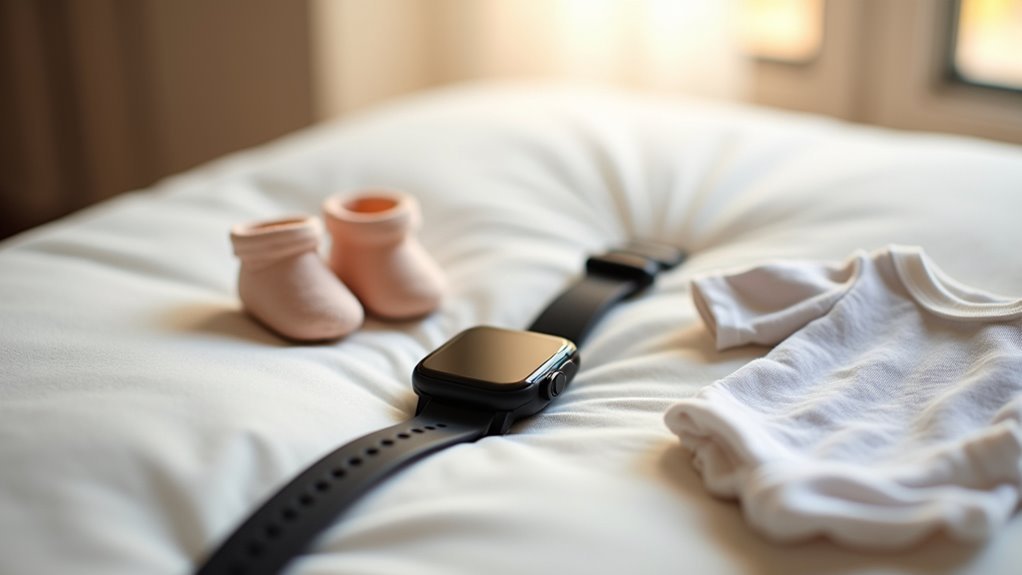
As your body undergoes dramatic physiological changes during pregnancy, monitoring heart rate variability (HRV) and blood pressure becomes essential for detecting potential health risks early.
Your autonomic nervous system balance shifts considerably, affecting cardiovascular function while increased blood volume and hormonal changes create additional stress on your heart.
Wearable devices offer you several key advantages:
- Continuous monitoring – Track changes 24/7 without invasive procedures
- Early detection – Identify hypertensive disorders before they become serious
- Data-driven insights – Analyze trends to understand your body’s patterns
- Cost-effective care – Reduce frequent clinic visits while maintaining thorough health oversight
Studies show HRV typically decreases during pregnancy, indicating potential cardiac compromise. Conditions like gestational diabetes and pre-eclampsia can further compromise your cardiovascular health during this critical period.
Enhanced Communication With Healthcare Providers
While traditional prenatal care relies on periodic check-ups and manual data collection, wearable technology transforms how you communicate with your healthcare team throughout pregnancy. Your device continuously shares essential health data in real-time, enabling your provider to monitor changes and respond quickly to concerns.
| Traditional Care | Wearable-Enhanced Care |
|---|---|
| Monthly appointments only | Continuous data sharing |
| Manual symptom reporting | Automated health tracking |
| Limited data between visits | Real-time monitoring alerts |
| Delayed issue detection | Immediate concern identification |
| One-way communication | Two-way feedback system |
This enhanced communication creates a collaborative care environment where your provider can offer personalized guidance based on your actual health patterns. The integration with electronic health records guarantees accuracy while AI-powered analysis provides insights for tailored care plans. Research shows that wearables significantly improve maternal health outcomes by allowing healthcare providers to intervene promptly when potential complications arise.
Peace of Mind Through 24/7 Health Surveillance
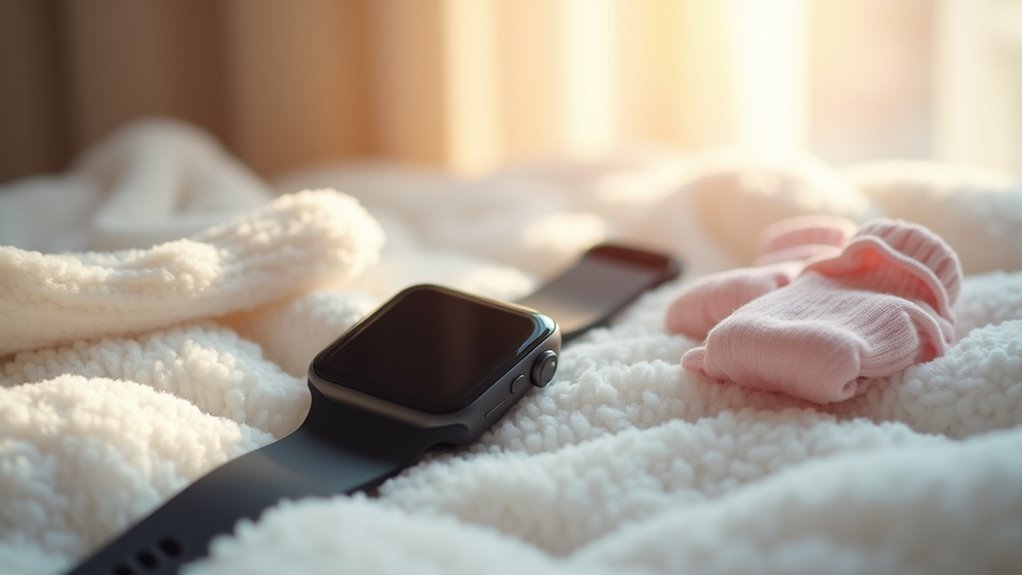
You’ll receive instant notifications when your health metrics shift outside normal ranges, allowing you to address concerns immediately rather than waiting for your next appointment.
This continuous monitoring helps identify potential complications like gestational diabetes or preeclampsia in their earliest stages, when they’re most manageable.
The constant reassurance that your pregnancy is being tracked around the clock greatly reduces the worry and stress that often accompany expectant mothers through their journey. Wearable devices can track changes in heart rate variability throughout each trimester, providing valuable insights into your overall health and fitness levels during pregnancy.
Real-Time Health Alerts
When pregnancy complications develop, every minute counts—and that’s where real-time health alerts from wearable technology become indispensable. Your wearable device continuously monitors essential signs and automatically sends immediate notifications to your healthcare team when parameters stray from safe ranges.
These intelligent alerts can detect early warning signs of serious conditions like preeclampsia or gestational diabetes before you even notice symptoms.
Here’s how real-time alerts protect you:
- Instant notifications reach your medical team through secure apps and dashboards
- Early intervention prevents minor issues from becoming major complications
- Reduced care delays bridge gaps between routine prenatal appointments
- Smart filtering combines automated alerts with human evaluation to minimize false alarms
Modern devices also include stress management tools that provide guided breathing exercises when elevated stress levels are detected. This technology guarantees you’re never truly alone during your pregnancy journey.
Early Risk Detection
Beyond emergency alerts, your wearable device functions as a sophisticated early warning system that identifies potential complications days or weeks before they become serious threats. Through continuous data collection, these devices track subtle changes in your essential signs and physiological parameters that traditional prenatal visits might miss.
Machine learning algorithms analyze patterns in your health data to predict risks like preterm birth and gestational diabetes. This predictive capability enables timely medical intervention, potentially improving outcomes for both you and your baby. Research from Stanford University demonstrates how activity and sleep data from wearables can reveal correlations between abnormal profiles and increased preterm birth likelihood.
| Health Parameter | Risk Detection |
|---|---|
| Blood Pressure | Hypertension risks |
| Heart Rate Variability | Cardiovascular complications |
| Physical Activity | Preterm birth indicators |
| Sleep Patterns | Stress-related complications |
| Respiratory Rate | Asthma management needs |
Your wearable’s longitudinal monitoring helps healthcare providers make enhanced clinical decisions while reducing unnecessary hospital visits.
Reduced Maternal Anxiety
The constant uncertainty that accompanies pregnancy can create overwhelming stress, but wearable technology transforms this experience by providing reassuring 24/7 health surveillance.
You’ll receive real-time data on your essential signs and physical activity, eliminating the anxiety of waiting between prenatal appointments to understand your health status.
This continuous monitoring offers four key psychological benefits:
- Immediate alerts notify you of any deviations from normal ranges, enabling timely medical intervention.
- Early symptom awareness helps you recognize changes like sleep disruptions that could indicate pregnancy risks.
- Enhanced communication with your healthcare team through automated data sharing and prompt provider outreach.
- Empirical reassurance provides objective data that counteracts subjective worries, giving you measurable control over your pregnancy journey.
The real-time feedback from wearable devices can significantly improve decision-making for both expectant mothers and their healthcare providers throughout the pregnancy journey.
Personalized Prenatal Care Plans With Data Insights
As wearable technology continues to evolve, it’s revolutionizing how healthcare providers approach prenatal care by enabling truly personalized treatment plans based on continuous data insights.
Your wearable device collects essential health parameters like heart rate variability and glucose levels, creating a thorough health profile that’s uniquely yours.
AI processes this data to identify patterns and anomalies, helping your healthcare provider detect potential issues like gestational diabetes and hypertension early.
This continuous stream of information allows your medical team to create customized care plans tailored to your specific health needs rather than relying on one-size-fits-all approaches. The challenge of developing personalized AI models for individual users requires overcoming significant variability in physiological characteristics between different pregnant women.
You’ll receive personalized recommendations and timely interventions that greatly improve your maternal health outcomes throughout pregnancy.
Managing Weight Gain and Physical Activity Levels
While your healthcare provider monitors your overall progress during routine visits, wearable technology empowers you to track two critical aspects of pregnancy health on a daily basis: weight gain and physical activity levels.
Smart scales and fitness trackers work together to help you stay within recommended weight gain ranges based on your BMI category. You’ll receive real-time feedback that helps identify concerning trends early, whether you’re gaining too much or too little weight.
Recent research from Babyscripts and George Washington University analyzed data from over 50,000 pregnancies and found that increased app engagement significantly improved adherence to healthy weight gain guidelines.
Here’s how wearables support healthy pregnancy management:
- Monitor daily movement – Track steps, heart rate, and activity levels automatically
- Share data seamlessly – Bluetooth connectivity sends information directly to your healthcare team
- Receive motivational alerts – Get reminders when activity levels drop too low
- Make timely adjustments – Access immediate feedback to modify diet or exercise habits
Reducing Unnecessary Medical Interventions
Beyond tracking your daily health metrics, wearable technology serves as a powerful tool for preventing unnecessary medical procedures during pregnancy. These devices detect potential issues before they escalate, reducing your need for invasive procedures.
Real-time alerts sent to your healthcare provider help address anomalies promptly without over-intervening in your care. Continuous monitoring helps identify when you don’t actually need medication, reducing unnecessary drug exposure during pregnancy.
Wearable technology enables precise medical decision-making, ensuring pregnant women receive only necessary interventions while avoiding overtreatment and unnecessary medication exposure.
By catching complications early, you’ll likely avoid pregnancy-related hospitalizations and readmissions. This proactive approach leads to significant cost savings for healthcare systems while ensuring you receive appropriate care.
The technology’s ability to provide accurate, continuous data means your medical team can make informed decisions about interventions, ensuring you only receive treatments that are truly necessary.
Improving Long-Term Maternal and Infant Health Outcomes
Wearable technology’s impact extends far beyond immediate pregnancy care, creating lasting benefits that protect both mothers and babies for years to come.
By collecting longitudinal data throughout your pregnancy, these devices help healthcare providers understand patterns that influence long-term health outcomes for both you and your child.
Here’s how wearable tech improves your family’s future health:
- Prevents chronic conditions – Early detection of gestational diabetes and hypertension reduces your risk of developing type 2 diabetes and cardiovascular disease later.
- Optimizes fetal development – Continuous monitoring guarantees proper growth patterns that support lifelong cognitive and physical health.
- Reduces preterm birth complications – Activity and sleep tracking identifies risks early, preventing developmental delays.
- Enhances parental engagement – You’ll develop healthier habits that benefit future pregnancies and family wellness. Traditional pregnancy tracking occurs only every few weeks and misses critical patterns between appointments.
Frequently Asked Questions
Are Pregnancy Wearables Safe for Both Mother and Baby?
Pregnancy wearables are generally safe when you follow manufacturer guidelines. They’re designed with medical-grade standards, comfortable materials, and encrypted data protection. However, you should consult your healthcare provider before using any monitoring device.
How Much Do Pregnancy Tracking Wearables Typically Cost?
You’ll find pregnancy tracking wearables range from $100 for basic models to over $1,000 for advanced smart belly bands. Most health monitoring devices cost between $100-$500, depending on features you’re seeking.
Do Insurance Plans Cover Wearable Pregnancy Monitoring Devices?
You’ll find that some insurance plans now cover wearable pregnancy devices. Medicaid’s expanded coverage in states like Virginia and Arkansas, plus growing payer support, means you’re more likely to get coverage today.
Can Wearables Replace Regular Prenatal Doctor Appointments?
You can’t replace regular prenatal appointments with wearables alone. While they provide continuous monitoring and early detection, you’ll still need professional medical interpretation, physical exams, and expert guidance throughout your pregnancy.
What Happens if the Wearable Device Malfunctions During Pregnancy?
If your wearable device malfunctions, you’ll miss critical health alerts like preeclampsia warnings, face incomplete data collection, and need more frequent doctor visits. You should maintain backup monitoring methods and seek immediate technical support.

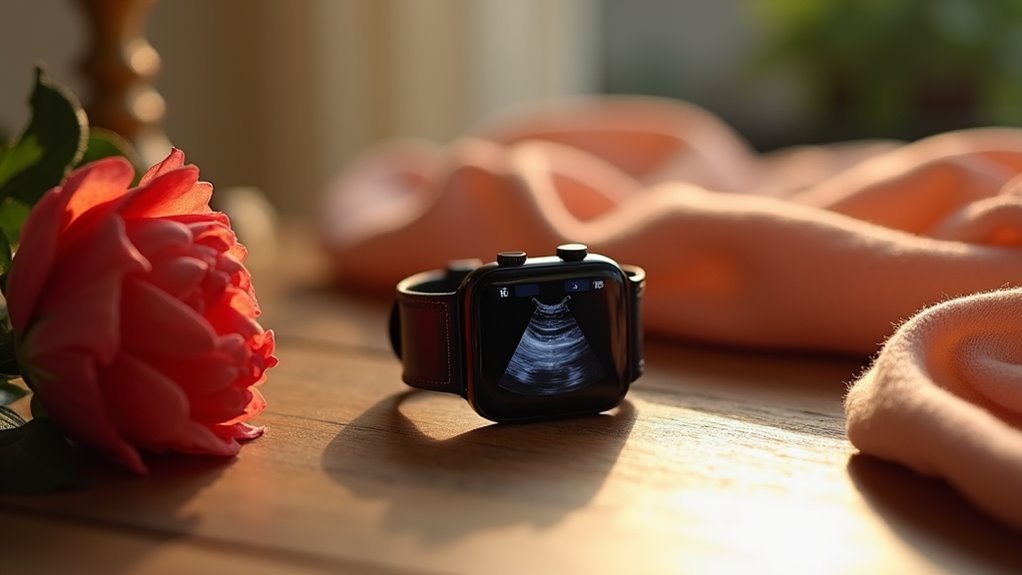
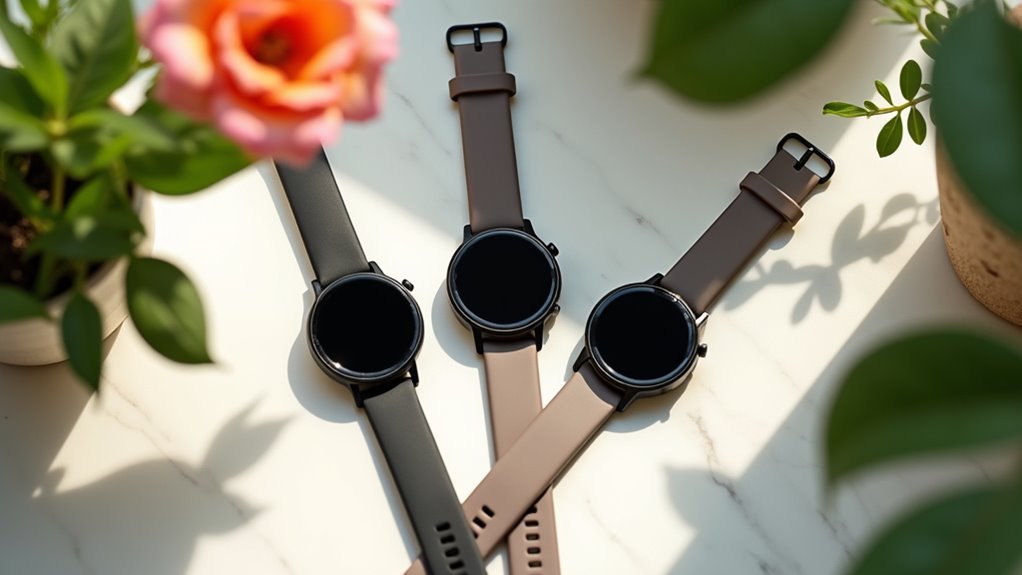
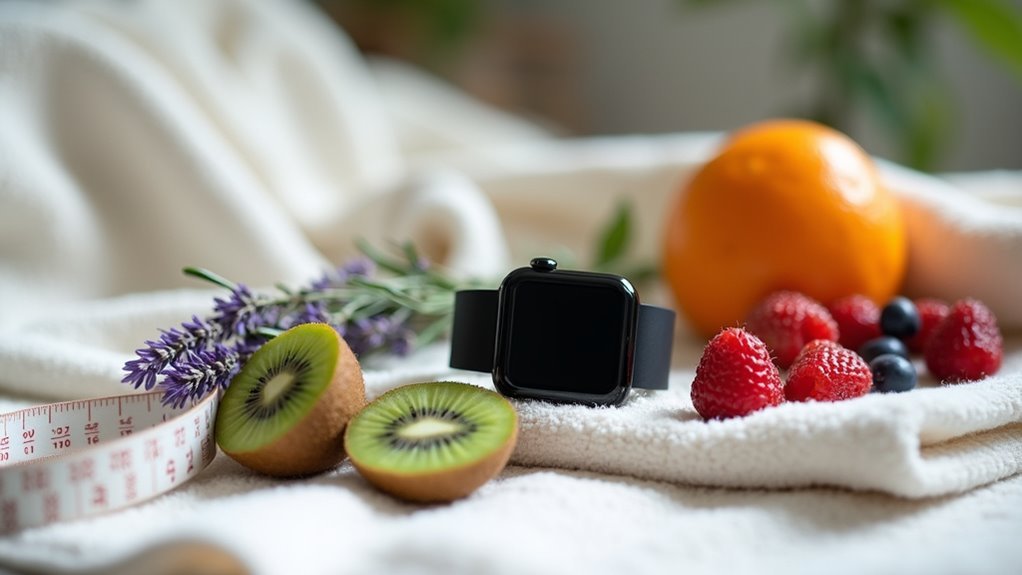
Leave a Reply